Build muscle fast - 7 exercises to build muscle in the gym
A workout plan for each body area
When it comes to building muscle, it can sometimes feel like it’s taking forever to see any muscle growth, which can be frustrating! But, with the right plan in place and focusing on key exercises that work each muscle group, believe us - you’ll be shocked at how quickly you see results!
In this blog, we delve into why building muscle is so important as part of your fitness routine, the best ways to build muscle, and the best exercises you can do in the gym to help enhance the main muscle groups.
Jump to:
● What is the best way to build muscle?
● How long does it take to build muscle?
● How long should you spend in the gym to build muscle?
● How many exercises per muscle group?
● Best shoulder muscle exercise
Benefits of building muscle
For many people, the primary goal of hitting the gym is to help with weight loss and toning up, so muscle building can often be overlooked. But building muscle can actually have numerous benefits, not just on your physical health but also your wellbeing.
Key benefits of building muscle:
● Enhances strength
● Builds endurance and overall physical performance
● Boosts your metabolism, helping with weight management
● Improves bone density
● Reduces the risk of injury
● Enhances posture and balance
● Improved mood and reduced stress levels.
What is the best way to build muscle?
The best way to build muscle involves a combination of targeted resistance training, proper nutrition, adequate rest, and most importantly, consistency.
Making sure you have a balanced diet that includes proteins, healthy fats, carbohydrates, and plenty of fruits and vegetables will also support overall muscle development.
Consistency across not only your workouts but also your diet will allow you to gradually increase the weights you’re lifting or resistance you're using to continuously challenge your muscles and stimulate growth.
How long does it take to build muscle?
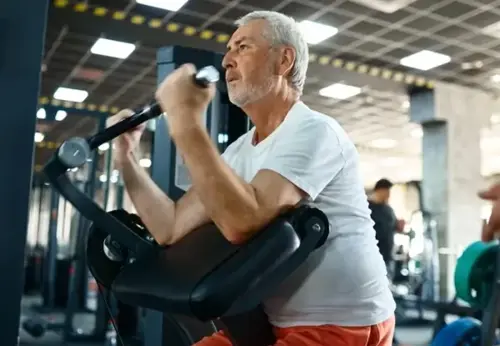
The ability to gain muscle varies from person to person based on a variety of factors like genetics, diet, exercise routine, and overall health.
Noticeable changes in muscle mass can occur within a few weeks to a few months of adapting to a new routine. But substantial muscle growth usually takes several months to years of dedicated training.
How long should you spend in the gym to build muscle?
This again really varies from person to person as it all depends on additional factors such as your build, diet and genetics.
We recommend spending approximately 20 - 30 minute workouts with weight training. Doing this a few times a week and targeting different muscle groups will help you see results quicker than focusing on just one muscle group.
How many exercises per muscle group?
How many exercises you do per muscle group depends on what your end goals is. The general rule of thumb is:
o To build strength: 2 – 6 sets, 5 – 8 reps
o To build power: 2 – 4 sets, 6 – 10 reps (explosive)
o To build muscle: 3 – 5 sets, 6 – 12 reps
o Weight loss: 3 sets, 10 – 12 reps
Like we said before, consistency is key when it comes to sticking to a workout routine, especially for building muscle quickly.
By regularly repeating specific exercises targeting various muscle groups, you not only build your muscle strength but also your endurance.
Repetition of exercises also massively helps with tracking and monitoring your muscle development.
While you may start with just a few reps in the first week, staying consistent with your workout routine, you should then aim to increase the number of reps as you go.
In the following section, we've outlined the exercises we believe are among the most effective for targeting each of the primary muscle groups
7 best gym exercises to build muscle
When it came to picking just seven exercises to help you build muscle, out of the hundreds of fantastic exercises out there, as you can imagine that was pretty difficult!
But our experienced fitness team has handpicked the top exercises for each of the 7 main muscle groups that are straight-forward and accessible for most people at the gym.
Don't worry, we've also included a few extra examples in case you’d like to go beyond the picks we’ve made.
1. Best abs exercises: Russian twists
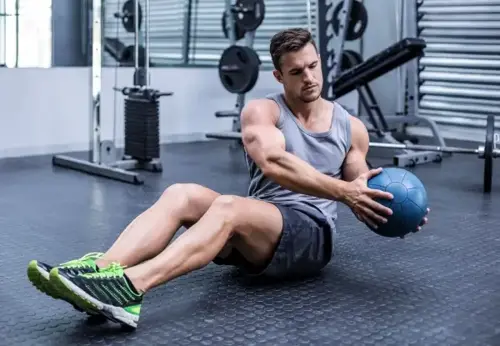
There are four key muscles within your abdominals:
- The rectus abdominis
- Transversus abdominis
- External obliques
- Internal obliques.
To help build the muscles in your abs, it’s vital to put aside the time to train and refine each of the four muscle groups. While many abdominal exercises engage multiple areas, they often emphasise one particular muscle group.
This is why the russian twist is one our favourites as it uses nearly all key muscles.
How to do a Russian twist
Setup: Sit on the floor with bent knees and feet flat, forming a V-shape with your torso and thighs.
Engage Core: Tighten your abdominal muscles by pulling your belly button toward your spine and lift your feet off the ground a few inches, balancing on your bum.
Twist: Hold your hands together or a weight in front of your chest and twist your torso from side to side, bringing your hands or the weight towards the floor beside each hip.
Repeat: Alternate twists for 10-20 repetitions on each side in a controlled and steady manner, focusing on core engagement and balance throughout the exercise.
Other exercises for your abdominal muscles
If Russian twists aren’t for you, don’t worry, we’ve got you covered with a few more of our favourite exercises that will really get your abs burning (in a good way!).
Here are four other great examples of workouts that will really help to buitld your ab muscles quickly.
1) Crunches
Crunches are where you lie on your back, but with your knees bent. Place your hands behind your head, and lift your shoulders off the ground, aiming to bring your rib cage towards your pelvis (this starts engaging your abdominal muscles).
2) Leg raises
Leg raises are where you lie flat on your back, raise your legs off the ground while keeping them straight, and then lower them back down slowly whilst engaging your abdominal muscles.
3) Sit ups
Sit-ups are where you lie on your back, bending your knees, and lift your upper body off the ground, aiming to bring your chest towards your knees. This is different to crunches as you effectively sit up fully, but with crunches your shoulders and head raise only.
4) Planking
A plank is where you hold a push-up position with your body in a straight line from head to heels (without raising your bottom too high). This exercise is also great for your back, shoulders and glutes - but importantly, your core and abs will have a great workout.
Best chest exercises: Bench Press
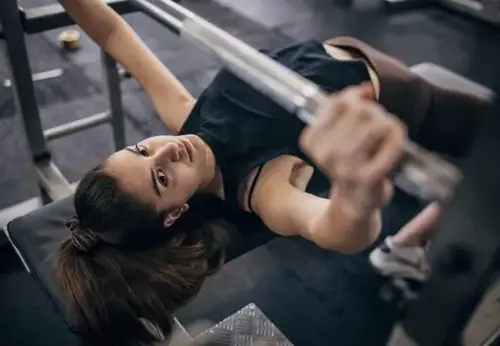
Chest exercises can feel like a challenge, especially when looking at the level of weights involved - but don’t worry, this exercise will allow you to start on those lower weights and work your way up. Its range and scalability is why we picked it!
A good place to start is with the classic bench press. It's a fantastic exercise for building those chest muscles! For beginners, having someone nearby to spot you can provide reassurance and help ensure proper form and balance while lifting weights (which is vital in ensuring you’ll get the most benefit).
How to bench press
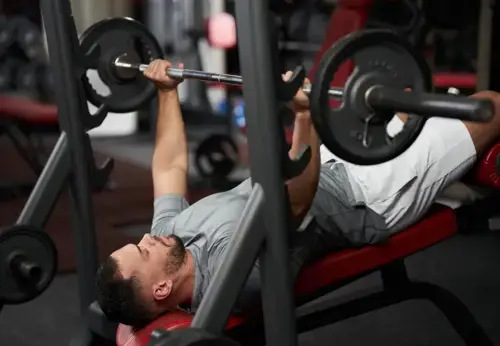
Setup: Lie flat on a bench with your feet planted firmly on the ground. Position your body so that your eyes are directly under the barbell. Grip the barbell slightly wider than shoulder-width apart, with your palms facing away from you.
Lift: Lift the barbell off the rack and extend your arms fully, holding the weight directly above your chest. Lower the barbell towards your chest in a controlled manner, keeping your elbows at a 45-degree angle to your body.
Press: Exhale and push the barbell back up to the starting position, fully extending your arms without locking your elbows. Keep your back flat on the bench and maintain stability throughout the movement.
Repeat: Repeat as you’d like, lowering and pressing the barbell with control. Once finished, carefully place the barbell back onto the rack, ensuring it’s secure.
Other exercises for your chest muscles
Instead of a bench press, here are four more exercises that you could do to help build your chest muscles quickly.
1) Cable crossover
A cable crossover involves standing between two cable machines with handles attached to the high pulleys, then pulling the handles across the body in a controlled motion.
2) Chest squeeze
For this exercise, you can opt for either the chest press machine or resistance bands. The key is to bring both hands together while pulling against the resistance in front of the chest.
3) Dumbbell pullover
The dumbbell pullover workout involves lying on a bench with a dumbbell held securely above the chest, then lowering the weight behind the head in a controlled motion. Repeating as you’d like!
4) Weighted stack and dumbbell chest press
For a weighted stack and dumbbell chest press, start by lying flat on the bench with your feet fully on the ground on either side of the bench. Grip a dumbbell in each hand. With both hands gripping the dumbbells, move them to the front of your chest and push upwards so they are straight above your chin. Raise and position in the centre of your chest, hands level with shoulders and raise arms to meet in the middle above your chest.3. Best tricep exercises: Cable rope extension
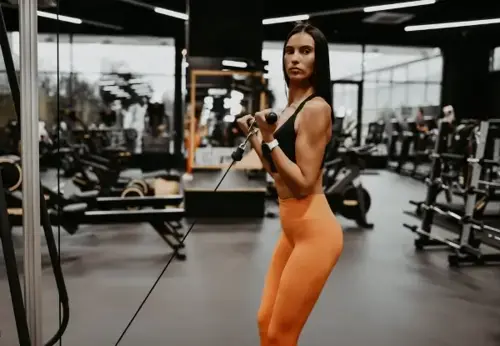
Tricep exercises often get overlooked in favour of biceps workouts, but they're crucial for building arm muscle mass.
While there are numerous exercises to target the triceps, we think the cable rope extension are one of the best. Using the cable machine, this exercise ignites those triceps and leaves your arms burning!
How to do cable rope extensions
Setup: Attach a rope handle to the high pulley of a cable machine. Stand facing the machine with your feet shoulder-width apart. Grasp the ends of the rope with both hands, palms facing each other, and step back slightly to create tension in the cable.
Starting Position: Keep your elbows close to your sides and bent at a 90-degree angle. Your upper arms should be stationary and perpendicular to the floor. Lean slightly forward at the hips to ensure proper alignment.
Extend: Extend your arms downward by straightening your elbows, pushing the rope down until your arms are fully extended. As you do this, separate the ends of the rope to engage your triceps fully. Keep your upper arms stationary and focus on squeezing your triceps at the bottom of the movement.
Repeat: Slowly return to the starting position by bending your elbows, allowing the rope to come back up until your elbows are at a 90-degree angle again. Repeat for the desired number of repetitions, maintaining control and proper form throughout the exercise.
Other exercises for your tricep muscles
If tricep dips aren’t your thing, and you would prefer to experiment with some new equipment, here are four more you can give a go.
1) Tricep dips
To perform tricep dips, start by sitting on the edge of a sturdy chair or bench with your hands gripping the edge, fingers pointing forward. Slide off the edge so your weight is supported by your arms, with your legs extended in front of you, heels touching the ground. Keep your elbows close to your body as you lower yourself by bending your elbows to a 90-degree angle, ensuring your back stays close to the chair or bench. Push through your palms to straighten your arms and raise your body back to the starting position. Repeat for the desired number of repetitions, maintaining control throughout the movement to effectively target the triceps.
2) Plank raises
A plank raise involves starting in a static plank position but raising one arm at a time, fully extending it outwards, then returning to the starting position in a controlled manner.
3) Lying triceps extensions
This workout involves lying on a bench, holding a barbell or dumbbells above your forehead, then bending your elbows to lower the weight towards your head and returning it back to the starting position. It’s vital to ensure a proper grip, and we would recommend using a lower weight to be on the safe side.
4) Dumbbell jab
The dumbbell jab exercise is where you hold a dumbbell in each hand, standing in a wide, comfortable stance (feet firmly rooted), and repeatedly extend one arm forward in a punching motion while maintaining control and stability throughout the movement.
4. Best back exercises: Deadlifts
Not only does building your back muscle improve your overall physique and strength, but it also helps with reducing potential injuries and improves posture.
It is important to note that ensuring correct form during back exercises is vital to prevent injuries. Deadlifts are a great choice as they allow for easy form checks, making them one of the best back exercises.
How to do a deadlift
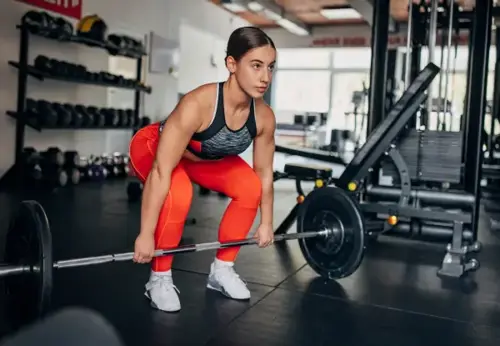
Setup: Stand with your feet hip-width apart, with the barbell centred over your feet. Bend at your hips and knees to lower your torso and grip the barbell with an overhand grip, hands shoulder-width apart. Your arms should be straight, and your back should be flat, with your chest up and your shoulders back.
Lift: Keeping your back straight and your core engaged, drive through your heels to lift the barbell off the ground. As you lift, focus on pushing your hips forward and straightening your knees, maintaining a neutral position of your spine throughout the movement.
Stand: Once the barbell passes your knees, fully extend your hips and stand tall, pulling your shoulders back and squeezing your glutes at the top of the movement. Keep the barbell close to your body throughout the lift, and avoid leaning back excessively or rounding your lower back.
Lower: To lower the barbell, hinge at your hips and bend your knees while keeping your back straight. Lower the barbell back to the ground with control, maintaining proper form and keeping it close to your body throughout the descent.
Other exercises for your back muscles
If you’re already an expert in deadlifting and on the hunt for some new back exercises, here are four more of our favourite more advanced ones to try and believe us - they can be tricky!
1) Rowing machine
A rowing machine workout is exactly the same as how you would row, the only difference is you remain still. You sit on the sliding seat, gripping a handle attached to a cable, and pulling it towards you while extending your legs, then returning to the starting position by leaning back and bending your knees.
2) Weighted stack low row
Sit at the machine with your feet on the footrests and knees slightly bent. Grasp the handle with both hands, keep your back straight, and engage your core. Pull the handle towards your torso by driving your elbows back, squeezing your shoulder blades together. Avoid using your lower back for momentum. Slowly extend your arms to return to the starting position. Repeat for the desired number of repetitions, maintaining proper form throughout.
3) Wide-grip pull up
A wide grip pull-up is where you pull yourself up to a bar with hands positioned wider than shoulder-width apart. Lower yourself carefully before rising back up!
4) SkiErg
A SkiErg workout involves using a machine that simulates the motion of cross-country skiing, providing a full-body cardiovascular and strength-building workout.
5. Best leg exercises: Leg press
Having strong legs isn't just about the muscle definition, it’s about being able to tackle everyday tasks like walking and stability. That's why it is important to include leg workouts into your routine. It’s key for staying healthy and mobile.
One of our favourite machines is the leg press as it’s perfect for building leg muscles, but also really gets your glutes working.
How to do leg press exercises
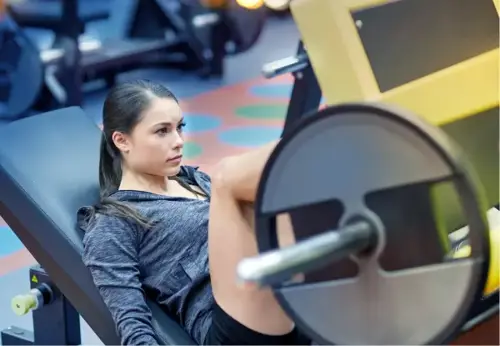
Setup: Sit on the leg press machine with your back flat against the backrest and your feet hip-width apart on the footplate. Adjust the seat so that your knees are at a 90-degree angle when your legs are fully extended.
Press: Grip the handles on the sides of the seat for stability and push the footplate away from you by extending your legs. Keep your heels firmly planted on the footplate and your back pressed against the backrest throughout the movement.
Lower: Bend your knees to lower the footplate back towards your body in a controlled manner, allowing your knees to come towards your chest without lifting your lower back off the seat.
Repeat: Perform the desired number of reps, focusing on smooth and controlled movements. It’s important to avoid locking out your knees at the top of the movement and maintain proper form throughout to prevent injury. Gradually adjust the weight as needed to challenge your muscles when you’re ready.
Other exercises for your leg muscles
Alongside using the leg press machine, here are our next four favourite workouts to help build your leg muscles rapidly.
1) Squats
Simple yet effective - a must in any exercise plan! Squats are where you stand with your feet grounded, slightly wider than shoulder-width apart. Now lower your body by bending your knees and hips, then return to a standing position but keeping your back straight and heels on the ground. It’s a great all-rounder exercise that engages muscles in your thighs, hips, and glutes.
2) Romanian deadlift
A Romanian deadlift is where you hold a barbell with a straight back, hinging at the hips to lower the weight down the thighs while maintaining a slight bend in the knees, and then returning to an upright position by using your legs - contracting your hamstrings and glutes.
3) Reverse lunge
A reverse lunge is where you step backward with one leg, lowering your body until both knees are bent at 90-degree angles, then return to the starting position and repeat on the opposite leg.
4) Glute bridges
A glute bridge is where you lie on your back with knees bent, feet flat on the floor, then lift your hips upward until your body forms a straight line from shoulders to knees. Carefully lower yourself back to the starting position and repeat.
6. Best shoulder exercises: Shoulder press
Shoulders are another muscle that often is put on the back burner and isn’t seen as a priority muscle to focus on; but it’s one of the most important muscles you should be building, because your shoulders help to balance your upper body.
This means that by improving the muscles in your shoulders, you’ll also help with muscle growth in your back, arms and abdominals.
The number one exercise (in our opinion) to get the best shoulder muscle growth is the classic shoulder press.
How to do a shoulder press
Setup: Stand with your feet shoulder-width apart and grasp the dumbbells with an overhand grip, hands slightly wider than shoulder-width apart. Lift the dumbbells to shoulder height, palms facing forward, and elbows bent, so the weights are just above your collarbone.
Press Up: Inhale and brace your core muscles. Press the dumbbells overhead by extending your arms fully, but not locking out your elbows. Keep your head neutral, and the dumbbells should travel in a straight line above your head.
Lower: Slowly lower the dumbbells back down to the starting position, controlling the descent to maintain proper form. Keep your elbows facing out as you lower it down.
Repeat: Complete the desired number of repetitions, maintaining proper form and control throughout. Ensure your core remains engaged and avoid arching your lower back excessively. Adjust the weight as needed to challenge your muscles effectively. Now can keep those reps coming!
Other exercises for your shoulder muscles
In addition to the classic shoulder press, there are a few other exercises that we would recommend incorporating into your routine to help build the shoulder muscle area.
1) Lateral raise
A lateral raise is where you stand with two dumbbells in each hand, resting near your hips. Then you raise your arms out to the sides (arms always straight), with the backs of your hands on top (palms down), until the weights are shoulder height. Now carefully lower again, keeping your arms straight, until you’re back at start position.
2) Front raise
Similar to the lateral raise, a front raise is why you hold two dumbbells in each hand and raise them in front of your body to chest height. Then repeating.
3) Assisted pull up
An assisted pull-up is a variation of the traditional pull-up exercise where you use a machine, resistance band, or a spotter to help you lift your bodyweight
4) Rear delt flyes
Rear delt flyes is where you bend forward at the waist, holding two dumbbells, and then lift your arms out to the sides, parallel to the floor.
7. Best bicep exercises: Bicep curl
This may come as a surprise to some people but, building your biceps not only enhances arm strength and aesthetics, but also contributes to improved balance.
By engaging in targeted exercises, you can strengthen and stabilise your arm muscles, benefiting both current performance and future wellbeing.
That's why the bicep curl would be our number one choice because it’s simple and allows for easy form correction, and requires just one or two dumbbells, making it accessible for all fitness levels.
How to do a bicep curl
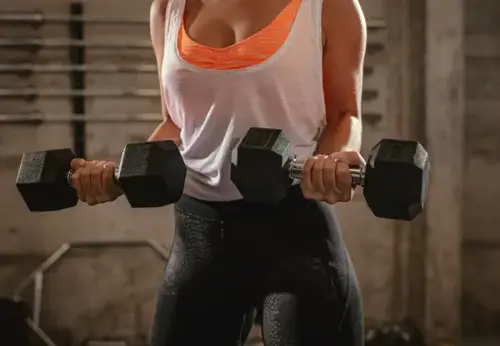
Setup: Stand up straight with your feet shoulder-width apart. Hold a dumbbell in each hand, with your arms fully extended downward, palms facing forward, and elbows close to your torso. This is your starting position.
Lift: Keeping your upper arms stationary, exhale as you curl the weights upward by flexing your biceps. Keep your elbows close to your body throughout the movement. Focus on contracting your biceps as you lift the weights.
Pause: Once your biceps are fully contracted and the dumbbells are at shoulder level, pause for a brief moment to squeeze your biceps at the top of the movement. Your palms should be facing your shoulders at this point.
Lower: Inhale as you slowly lower the dumbbells back to the starting position in a controlled manner, resisting the urge to let gravity pull them down too quickly. Keep your movements smooth and controlled throughout the entire exercise and repeat.
Other exercises for your bicep muscles
As one of the most popular muscles to build in the body, there are so many other bicep exercises that you can incorporate into your routine. Here are a few more examples of our favourite bicep workouts.
1) Chin ups
A chin-up is a strength training exercise where you lift your body upward by pulling yourself up to a bar to chin height, typically with your palms facing towards you, and carefully lowering yourself, before starting again.
2) High cable bicep curl
A high cable bicep curl is an exercise where you stand facing a cable machine, grasp the handles attached to the high pulley with an underhand grip, and then curl the handles towards your shoulders.
3) Concentrated bicep curl
A concentrated bicep curl is an isolation exercise performed by sitting on a bench, placing one elbow against the inner thigh, and curling a dumbbell towards the shoulder with your palm facing toward you with a strong grip.
4) Push ups:
A push-up is where you start in a plank position, lower your body by bending your elbows until your chest nearly touches the ground, then push yourself back up to the starting position, working those muscles in your chest, shoulders, and biceps.
How to find a personal trainer?
If you’re still unsure on where to begin with building muscle, a great way to get started is to have a few sessions with a personal trainer.
Personal trainers are beneficial because they provide customised workout plans tailored to individual fitness goals and needs, ensuring efficient and effective exercise routines. They also offer motivation, accountability, and expert guidance on proper form and technique, reducing the risk of injury and enhancing overall fitness results.
At Places Leisure, we offer personal training packages with some of the best trainers in your area that can provide you with a tailored experience to help you reach your fitness goals.
Where’s the best gym near me?
Our leisure facilities span across 80 locations in the UK. We’re passionate about helping you stay physically active and emotionally engaged in fitness, wellbeing and sport – however that may look to you.
Find your nearest Places Leisure gym today.